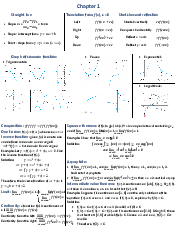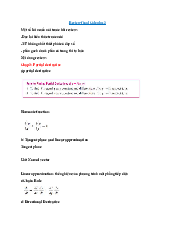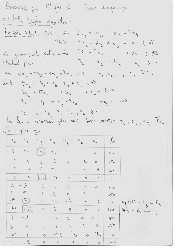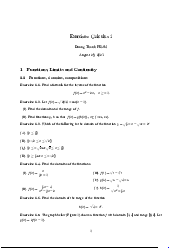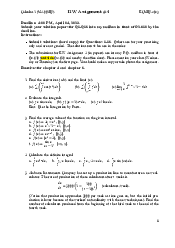










Preview text:
lOMoARcPSD|364 906 32 Even and Odd Functions 23.3 Introduction
In this Section we examine how to obtain Fourier series of periodic functions which are either even
or odd. We show that the Fourier series for such functions is considerably easier to obtain as, if the
signal is even only cosines are involved whereas if the signal is odd then only sines are involved. We
also show that if a signal reverses after half a period then the Fourier series will only contain odd harmonics. Prerequisites
Before starting this Section you should ... Learning Outcomes
On completion you should be able to ... "
• know how to obtain a Fourier series $
• be able to integrate functions involving sinusoids
• have knowledge of integration by parts %
• determine if a function is even or odd or neither
• easily calculate Fourier coefficients of even or ' odd functions !
1. Even and odd functions
We have shown in the previous Section how to calculate, by integration, the coefficients an (n =
0,1,2,3,...) and bn (n = 1,2,3,...) in a Fourier series. Clearly this is a somewhat tedious process and it is
advantageous if we can obtain as much information as possible without recourse to integration. In
the previous Section we showed that the square wave (one period of which shown in Figure 12) has
a Fourier series containing a constant term and cosine terms only (i.e. all the Fourier coefficients bn
are zero) while the function shown in Figure 13 has a more complicated Fourier series containing
both cosine and sine terms as well as a constant. lOMoARcPSD|364 906 32 4 π − π π π − 2 t 2 Figure 12: Square wave f ( t ) 2 2 2 t − Figure 13: Saw-tooth wave Task
Contrast the symmetry or otherwise of the functions in Figures 12 and 13. Your solution Answer
The square wave in Figure 12 has a graph which is symmetrical about the y-axis and is called an
even function. The saw-tooth wave shown in Figure 13 has no particular symmetry.
In general a function is called even if its graph is unchanged under reflection in the y-axis. This is equivalent to
f(−t) = f(t) for all t
Obvious examples of even functions are t2,t4,|t|,cost,cos2 t,sin2 t,cosnt.
A function is said to be odd if its graph is symmetrical about the origin (i.e. it has rotational symmetry
about the origin). This is equivalent to the condition f(−t) = −f(t)
Figure 14 shows an example of an odd function. 30HELM (2008): Workbook 23: Fourier Series lOMoARcPSD|364 906 32 ® f ( t ) t Figure 14 Examples of odd functions are
. A periodic function which is odd is the saw-tooth wave in Figure 15. f ( t ) 1 1 1 t − 1 − Figure 15
Some functions are neither even nor odd. The periodic saw-tooth wave of Figure 13 is an example;
another is the exponential function et. Task
State the period of each of the following periodic functions and say whether it is even or odd or neither. f ( t ) ( b ) f ( t ) t π π π π − π π t − π π − 2 − 4 4 2 (a) Your solution Answer
(a) is neither even nor odd (with period 2π) (b) is odd (with period π). HELM (2008): 31 Section 23.3: Even and Odd Functions lOMoARcPSD|364 906 32
A Fourier series contains a sum of terms while the integral formulae for the Fourier coefficients an
and bn contain products of the type f(t)cosnt and f(t)sinnt. We need therefore results for sums and products of functions.
Suppose, for example, g(t) is an odd function and h(t) is an even function. Let F1(t)
= g(t) h(t)
(product of odd and even functions) so F1(−t)
= g(−t)h(−t)
(replacing t by − t)
= (−g(t))h(t)
(since g is odd and h is even)
= −g(t)h(t) = −F1(t)
So F1(t) is odd. Now suppose
F2(t) = g(t) + h(t)
(sum of odd and even functions) ∴
F2(−t) = g(−t) + h(t)
= −g(t) + h(t) We see that
F2(−t) 6= F2(t) and
F2(−t) 6= −F2(t)
So F2(t) is neither even nor odd. Task
Investigate the odd/even nature of sums and products of
(a) two odd functions g1(t),g2(t)
(b) two even functions h1(t),h2(t) Your solution 32HELM (2008): Workbook 23: Fourier Series lOMoARcPSD|364 906 32 ® Answer
G1(t) = g1(t)g2(t)
G1(−t) = (−g1(t))(−g2(t))
= g1(t)g2(t) = G1(t)
so the product of two odd functions is even.
G2(t) = g1(t) + g2(t)
G2(−t) = g1(−t) + g2(−t)
= −g1(t) − g2(t) = −G2(t)
so the sum of two odd functions is odd.
H1(t) = h1(t)h2(t)
H2(t) = h1(t) + h2(t) A similar approach shows that
H1(−t) = H1(t)
H2(−t) = H2(t)
i.e. both the sum and product of two even functions are even.
These results are summarized in the following Key Point. HELM (2008): 33 Section 23.3: Even and Odd Functions lOMoARcPSD|364 906 32 Key Point 5 Products of functions (even) × (even) = (even) (even) × (odd) = (odd) (odd) × (odd) = (even) Sums of functions (even) + (even) = (even) (even) + (odd) = (neither) (odd) + (odd) = (odd)
Useful properties of even and of odd functions in connection with integrals can be readily deduced
if we recall that a definite integral has the significance of giving us the value of an area:
y = f ( t ) a b t Figure 16
gives us the net value of the shaded area, that above the t-axis being positive, that below being negative. Task
For the case of a symmetrical interval (−a,a) deduce what you can about and
where g(t) is an odd function and h(t) is an even function. 34HELM (2008): Workbook 23: Fourier Series lOMoARcPSD|364 906 32 ® g h ( t ) ( t ) − a a t − a a t Your solution
Z a g ( t ) dt =0 − a Z a Z h a ( t ) dt =2
h ( t ) dt − a 0
(Note that neither result holds for a function which is neither even nor odd.)
2. Fourier series implications
Since a sum of even functions is itself an even function it is not unreasonable to suggest that a Fourier
series containing only cosine terms (and perhaps a constant term which can also be considered as
an even function) can only represent an even periodic function. Similarly a series of sine terms (and
no constant) can only represent an odd function. These results can readily be shown more formally
using the expressions for the Fourier coefficients an and bn. Task
Recall that for a 2π-periodic function
If f(t) is even, deduce whether the integrand is even or odd (or neither) and hence
evaluate bn. Repeat for the Fourier coefficients an. Your solution HELM (2008): 35 Section 23.3: Even and Odd Functions lOMoARcPSD|364 906 32 f ( t )
f ( t ) sin nt = ( ) × ( ) = 1 Z π b n = dt π = 0 − π f ( t ) co s nt = ( ) × ( ) = 1 Z π 2 Z π a n = ( ) dt f π =
( t ) cos ntdt. π − π 0
It should be obvious that, for an odd function f(t), (odd function)dt = 0
Analogous results hold for functions of any period, not necessarily 2π.
For a periodic function which is neither even nor odd we can expect at least some of both the an and
bn to be non-zero. For example consider the square wave function: f ( t ) 1 π π 2 π − t Figure 17: Square wave
This function is neither even nor odd and we have already seen in Section 23.2 that its Fourier series
contains a constant and sine terms.
This result could be expected because we can write
where g(t) is as shown: 36HELM (2008): Workbook 23: Fourier Series lOMoARcPSD|364 906 32 ® g ( t ) 1 2 − π π 2 π 1 t − 2 Figure 18
Clearly g(t) is odd and will contain only sine terms. The Fourier series are in fact and Ta sk
For each of the following functions deduce whether the corresponding Fourier series contains
(a) sine terms only or cosine terms only or both (b) a constant term y 1 2 y − π π − π 0 π t 0 t 3 y 4 y − π 0 π t − π − a 0 a π t 5 y 6 y 0 2 − π π π t 0 2 − π π π t y − 0 2 π π π t 7 HELM (2008): 37 Section 23.3: Even and Odd Functions lOMoARcPSD|364 906 32 Your solution Task Answer
1. cosine terms only (plus constant).
5. sine terms only (no constant).
2. cosine terms only (no constant).
6. sine and cosine terms (plus constant).
3. sine terms only (no constant).
7. cosine terms only (plus constant).
4. cosine terms only (plus constant).
Confirm the result obtained for the triangular wave, function 7 in the last Task, by finding the
Fourier series fully. The function involved is
f(t) = |t| − π < t < π f(t + 2π) = f(t) Your solution 38HELM (2008): Workbook 23: Fourier Series lOMoARcPSD|364 906 32 ® Answer
Since f(t) is even we can say immediately bn = 0
n = 1,2,3,... Also 0 n even 2 π (after integration by parts) odd Also so the Fourier series is HELM (2008): 39 Section 23.3: Even and Odd Functions
Document Outline
- Introduction
- Prerequisites
- Learning Outcomes
- 1. Even and odd functions
- 2. Fourier series implications
